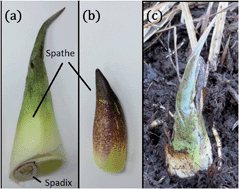Surface micro/nanotopography, wetting properties and the potential for biomimetic icephobicity of skunk cabbage Symplocarpus foetidus
Abstract
Lotus (Nelumbo nucifera) is known for its two remarkable properties: superhydrophobicity and thermogenesis; however, the relationship between these two properties remains obscure. Most botanists agree that thermogenesis helps to attract pollinators, while non-wetting helps to catch pollinators and prevents contamination. Here we investigate the surface micro- and nanotopography and wetting properties of eastern skunk cabbage (Symplocarpus foetidus), another thermogenic plant, which is known for its ability to melt snow. The skunk cabbage leaves are hydrophobic but not superhydrophobic, and they have high contact angle hysteresis (similar to the rose petal effect). We develop a heat transfer model to relate icephobicity with heat transfer and discuss the biomimetic potential that both thermogenic and superhydrophobic plants may have for icephobicity in soft materials.


 Please wait while we load your content...
Please wait while we load your content...